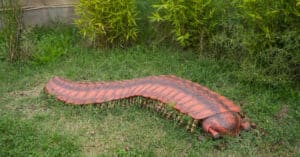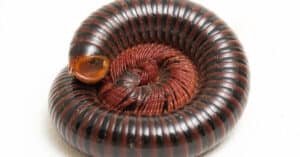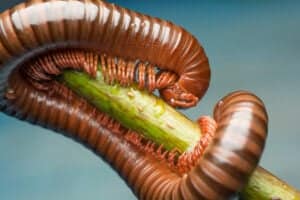Millipedes are fascinating creatures that have inspired curiosity and wonder in people for centuries. These many-legged invertebrates are interesting to look at, and they can be found in a variety of habitats all over the world. Here are 10 incredible millipede facts that will make you see them in a whole new light.
1. “Millipede” Means “Thousand Legs,” But They Rarely Have That Many
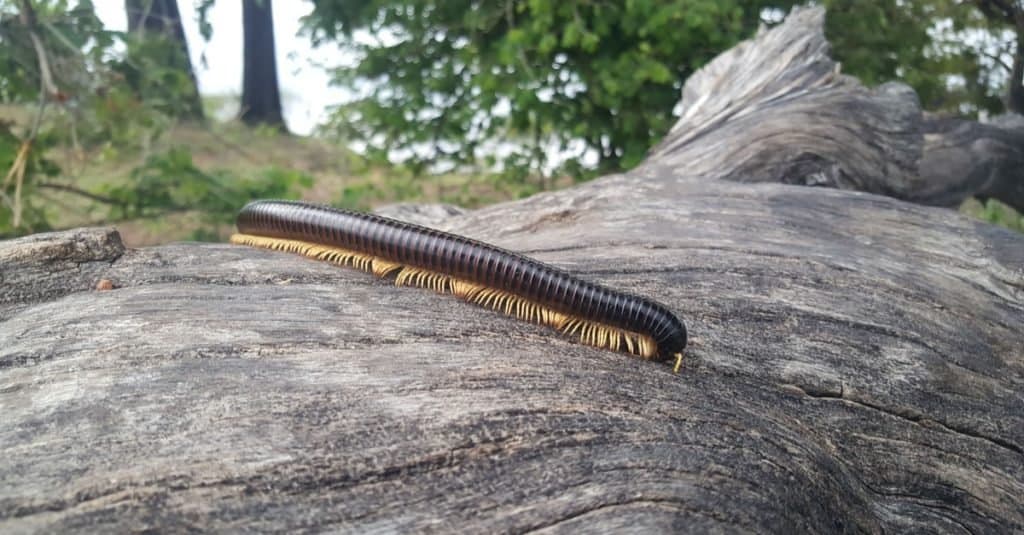
Millipedes typically have between 80-400 legs.
©Travel Telly/Shutterstock.com
The word “millipede” comes from the Latin words mille, meaning “thousand,” and ped, meaning “foot.” However, most millipedes don’t actually have 1,000 legs. The majority of millipede species only have between 80-400 legs.
2. The First Millipede To Have More Than 1000 Legs Was Found In 2020
Until recently, the highest number of legs ever counted on a millipede was around 750. In 2020, a team of researchers performing an environmental impact survey for a new mine in western Australia discovered a record-breaking species of millipede—Eumillipes persephone.
Adults of this species have 330 body segments and 1,306 legs. Because they live so deep underground (found more than 190 feet deep!), they have also evolved to be without eyes and pigmentation.
3. Millipedes Are Born Without Legs
Female millipedes can lay dozens or even hundreds of eggs at a time. They lay them in soil, and some species will even guard their eggs until they hatch. A few species have even been observed crafting little protective casings out of chewed-up leaves to protect each individual egg.
When millipedes are born, they emerge from their eggs as legless larvae. They soon molt for the first time to reveal 6 body segments and 3 pairs of legs.
4. Millipedes Grow Additional Body Segments and Leg Pairs With Each Molt
Molting is a process that all arthropods (arachnids, crustaceans, insects, including millipedes) undergo in order to grow. It involves shedding the exoskeleton—the hard, outer shell that protects their bodies—so that a new, larger one can form in its place.
As millipedes molt, they will grow additional body segments and leg pairs until they reach adulthood. Each new body segment that is added will have 2 pairs of legs (4 total) attached to it.
5. Many Species Eat Their Own Waste Pellets
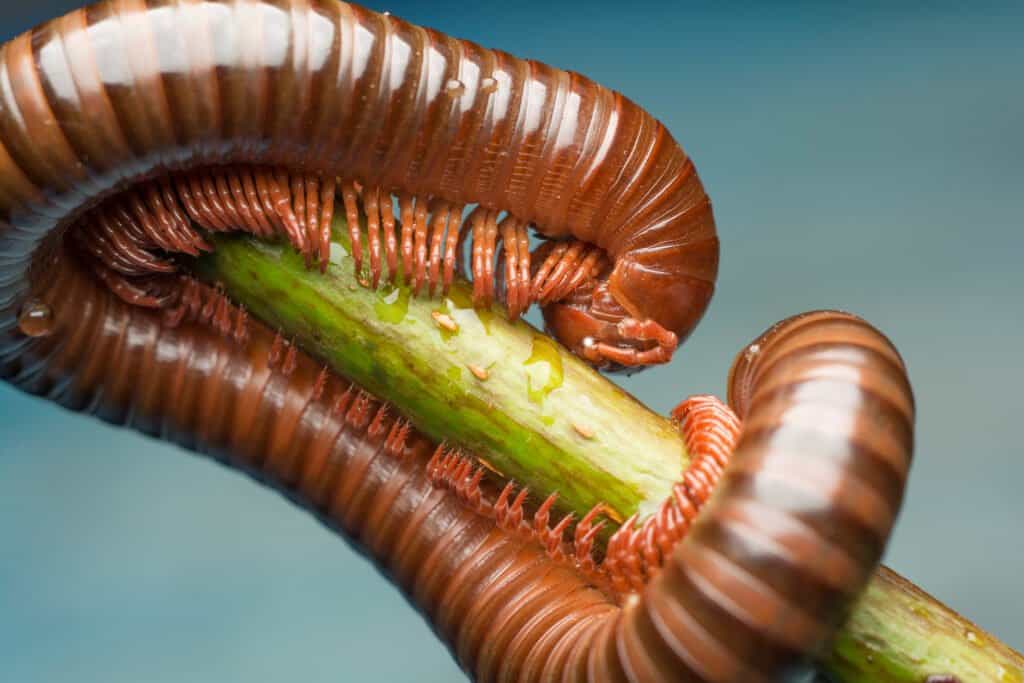
Millipedes eat decomposing plant material, waste, and other debris.
©Piyapong pc/Shutterstock.com
Millipedes eat decomposing plants and leaf litter. Eating this way classifies them as detritivores—eaters of detritus, waste, and debris. Some species will also eat fungi and dead animals.
This type of diet means that millipedes play an important ecological role in the decomposition of dead plants and animals and the recycling of nutrients back into the soil.
As they munch on their food, they excrete little pellets of waste. Some millipede species have been observed eating these pellets that they have defecated. One reasonable explanation for this seemingly odd behavior is that they are actually feeding on the funguses that grow in their waste material, which then provide additional nutritional compounds that they otherwise wouldn’t have access to.
6. Millipedes Defend Themselves With Chemicals

Most millipedes curl up into a ball to protect themselves.
Millipedes don’t bite or sting. They don’t have sharp claws to fight with, and despite their numerous legs, they’re not fast enough to outrun their predators. So, how do they defend themselves?
When threatened, most millipede species will curl up into a ball. This position allows them to use their hard exoskeleton as a 360-degree shield protecting their vulnerable underbelly.
Many millipede species take defense a step further and will also exude poisonous or foul-smelling chemicals from their bodies to ward off predators that might try to eat them. The two primary ingredients in this toxin are hydrochloric acid, which corrodes skin and eyes, and hydrogen cyanide, which can cause asphyxiation.
7. Lemurs Eat Millipedes To Get Intoxicated

Lemurs in Madagascar will sometimes eat toxic millipedes.
©Jearu/Shutterstock.com
Scientists have observed lemurs in Madagascar eating millipedes. Since the millipedes they eat release harmful chemicals as a defense mechanism, this likely causes them to become intoxicated.
This might not be about “getting high” recreationally. The chemical compounds in millipedes could potentially be used to help fight bacterial or parasitic infections. So if a lemur is feeling unwell or losing weight (possibly due to a parasite), the lemur can self-medicate by chewing on some millipedes.
8. Lemurs Also Use Millipedes As A Bug Repellent
In addition to eating millipedes, lemurs in Madagascar (and sometimes primates in other places as well) will rub millipedes deep into their fur. It’s thought that they do this to help ward off biting insects, as well as to protect themselves from bacteria and parasites who may try to infect any open wounds.
9. Millipedes Were The First Known Land Animal Over 430 Million Years Ago
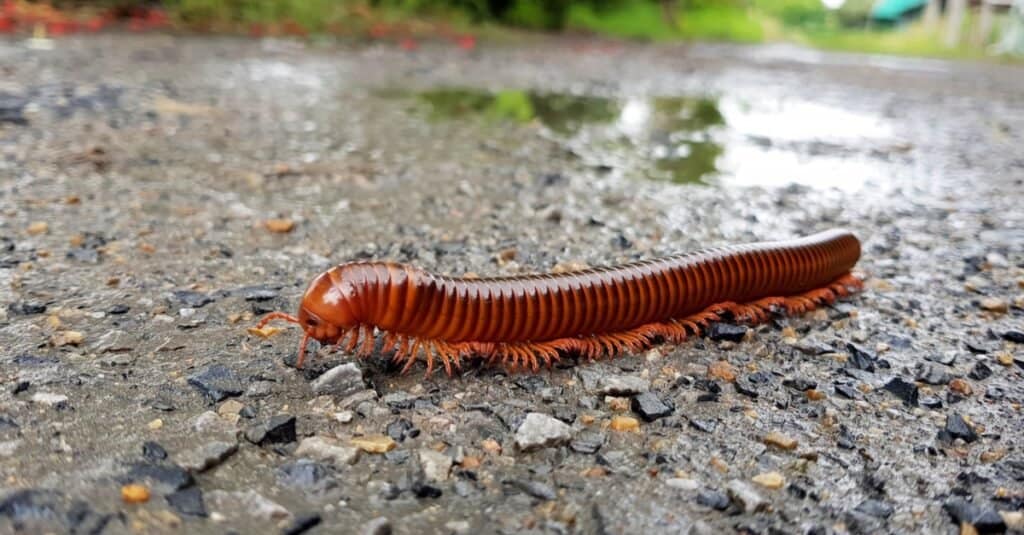
Fossil records indicate that millipedes were the first animal to live on land.
©Sawangkaew/Shutterstock.com
Biological life originated in the oceanic waters of Earth, probably around 3.8 billion years ago. For most of that time, all living organisms were aquatic.
According to fossil records, millipedes appear to be the first animal to breathe atmospheric oxygen and transition from living in water to living on land. The first known millipede fossil dates back to the Silurian period, approximately 430 million years ago.
10. Prehistoric Millipedes Could Grow Over 8 Feet Long!
The largest extant (still living) millipede species is the giant African millipede (Archispirostreptus gigas), which grows to be about one foot long. But millipede fossils that have been found indicate that some prehistoric species were much, much larger.
Around 300 million years ago, there lived a millipede species we now identify as Arthropleura armata. Fossils demonstrate that this species of millipede grew to be 8 feet long and nearly 2 feet wide! They are estimated to have weighed over 100 pounds and probably had few, if any, predators. Not only were these shockingly large millipedes the largest land invertebrate of their time period, they are the largest known land invertebrate of all time!
Up Next
The photo featured at the top of this post is © Piyapong pc/Shutterstock.com
Thank you for reading! Have some feedback for us? Contact the AZ Animals editorial team.




